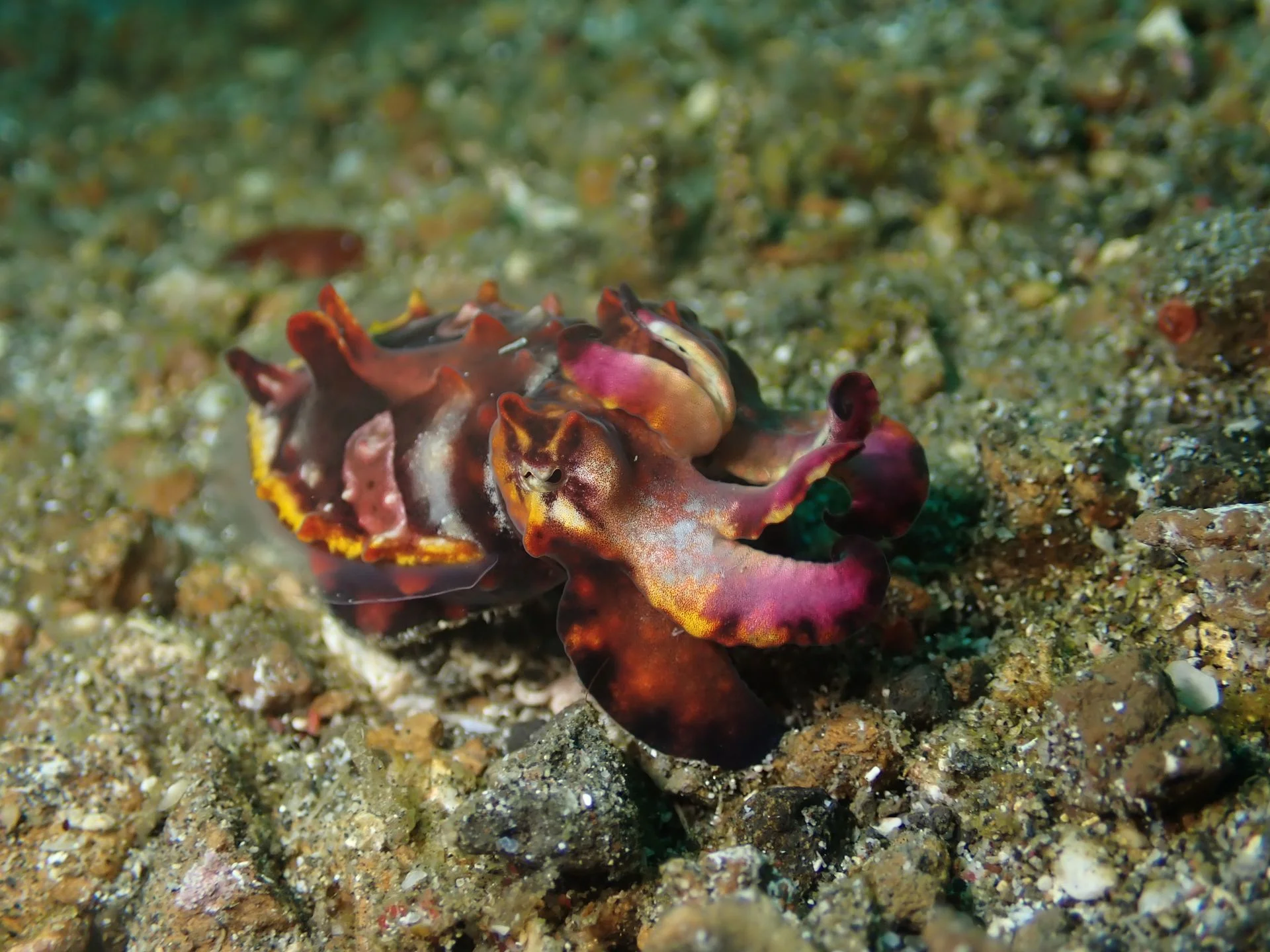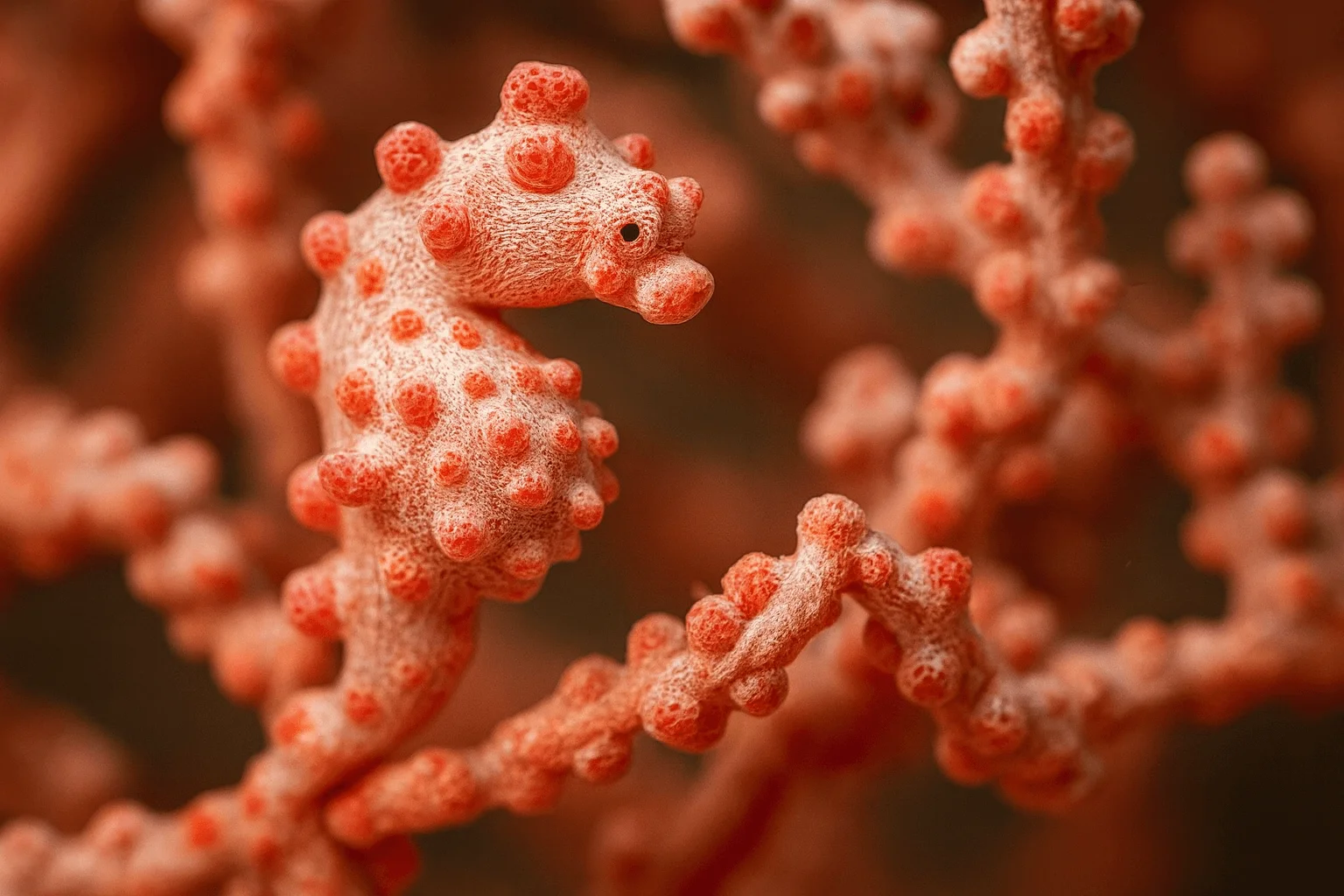Ghost Pipefish
Solenostomidae (e.g., Solenostomus paradoxus)

Ghost pipefishes (family Solenostomidae) are delicate syngnathiform fishes related to seahorses and pipefishes but in their own family. They excel at mimicry—matching feather stars, algae, or hydroids—and often hang nearly motionless with heads slightly down. Females develop a distinctive brood pouch by fusing their enlarged pelvic fins, where fertilized eggs are incubated until hatching.
🔬Classification
📏Physical Features
🌊Habitat Info
⚠️Safety & Conservation
Identification Guide

Key field marks:
- Large pelvic fins forming a brood pouch (females); males lack a closed pouch.
- Leafy/filamentous skin lobes along the body and fins; snout long and tubular.
- Head-down, body-aligned posture with host (crinoid arms, algae sprigs, hydroids).
- Dorsal and caudal fins small; pectoral fins used for fine hovering.
Differences from Similar Species
- Pipefish (Syngnathidae): typically stick-like, horizontal, no large pelvic fins; males brood eggs under the belly or in tail areas.
- Seahorse: upright with a prehensile tail that grasps; ghost pipefish do not grasp and show leafy lobes.
- Razorfish/Shrimpfish (Centriscidae): school vertically with armored plates; ghost pipefish are solitary/pairs with leafy outlines.
Juvenile vs. Adult
Juveniles are more transparent with finer lobes and often associate with floating algae. Adults show stronger patterns, fuller lobes, and females develop a closed brood pouch during breeding.
Top 10 Fun Facts about Ghost Pipefish

1. Family of Their Own
Ghost pipefish are not true pipefishes; they form the separate family Solenostomidae.
2. Brood Pouch Mothers
Females fuse pelvic fins to create a brood pouch that shelters eggs until hatching.
3. Seasonal Appearances
Often more numerous in calm seasons when algae and hydroids flourish.
4. Mimicry Masters
Species mimic crinoids (ornate), Halimeda algae (Halimeda), or seagrass (robust).
5. Pair Life
Frequently seen in male–female pairs, hovering near a shared host.
6. Gentle Feeders
Feed by suction on tiny crustaceans and zooplankton.
7. Soft Silhouettes
Leafy lobes break up the outline, defeating predator detection.
8. Low-Energy Lifestyle
Long periods of stillness conserve energy and aid camouflage.
9. Tiny Hatchlings
Larvae are planktonic, dispersing before settling into structured habitats.
10. Photographer’s Gem
Backlighting reveals translucent fins and pouch details—iconic macro subjects.
Diving & Observation Notes

🧭 Best Observation Approach
Search crinoids, Halimeda patches, hydroid bushes, gorgonians, and gentle rubble slopes (5–20 m). Approach slowly and low, matching their angle. Watch for pairs and for females with a brood pouch.
📸 Photography Tips
- Macro focus on the eye; use backlighting to reveal fin filaments and pouch texture.
- Compose with the host (crinoid/algae/hydroid) to tell the mimicry story.
- Use gentle strobes to avoid blown highlights on translucent fins; continuous AF helps with subtle sway.
⚠️ Safety & Ethics
- Do not relocate individuals or their hosts (crinoids, hydroids); avoid touching Halimeda/soft corals.
- Keep distance during brooding; repeated flashes can cause reorientation or retreat.
- Maintain perfect neutral buoyancy over fragile rubble and living hosts.
🌏 Local Dive Guide Insights
- Lembeh Strait (Indonesia): Regular sightings of ornate and robust species on muck slopes.
- Anilao (Philippines): Common around Halimeda beds and hydroids; pairs in calm coves.
- Bali (Tulamben/Seraya): Along rubble and algae fringes at 8–18 m.
- Raja Ampat (Indonesia): Rich reef edges with crinoids/gorgonians host multiple species.
Best Places to Dive with Ghost Pipefish

Lembeh
The Lembeh Strait in North Sulawesi has become famous as the muck‑diving capital of the world. At first glance its gently sloping seabed of black volcanic sand, rubble and discarded debris looks bleak. Look closer and it is teeming with weird and wonderful life: hairy and painted frogfish, flamboyant cuttlefish, mimic and blue‑ringed octopuses, ornate ghost pipefish, tiny seahorses, shrimp, crabs and a rainbow of nudibranchs. Most dives are shallow and calm with little current, making it an ideal playground for macro photographers. There are a few colourful reefs for a change of scenery, but Lembeh is all about searching the sand for critter treasures.

Anilao
Anilao, a small barangay in Batangas province just two hours south of Manila, is often called the macro capital of the Philippines. More than 50 dive sites fringe the coast and nearby islands, offering an intoxicating mix of coral‑covered pinnacles, muck slopes and blackwater encounters. Critter enthusiasts come for the legendary muck dives at Secret Bay and Anilao Pier, where mimic octopuses, blue‑ringed octopuses, wonderpus, seahorses, ghost pipefish, frogfish and dozens of nudibranch species lurk in the silt. Shallow reefs like Twin Rocks and Cathedral are covered in soft corals and teem with reef fish, while deeper sites such as Ligpo Island feature gorgonian‑covered walls and occasional drift. Because Anilao is so close to Manila and open year‑round, it’s the easiest place in the Philippines to squeeze in a quick diving getaway.

Raja Ampat
Raja Ampat, the “Four Kings,” is an archipelago of more than 1,500 islands at the edge of Indonesian West Papua. Its reefs sit in the heart of the Coral Triangle, where Pacific currents funnel nutrients into shallow seas and feed the world’s richest marine biodiversity. Diving here means gliding over colourful walls and coral gardens buzzing with more than 550 species of hard and soft corals and an estimated 1,500 fish species. You’ll meet blacktip and whitetip reef sharks on almost every dive, witness giant trevally and dogtooth tuna hunting schools of fusiliers, and encounter wobbegong “carpet” sharks, turtles, manta rays and dolphins. From cape pinnacles swarming with life to calm bays rich in macro critters, Raja Ampat offers endless variety. Above water, karst limestone islands and emerald lagoons provide spectacular scenery between dives.